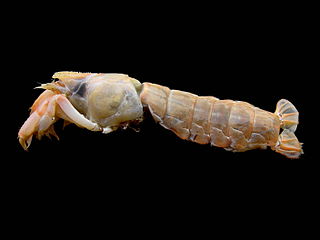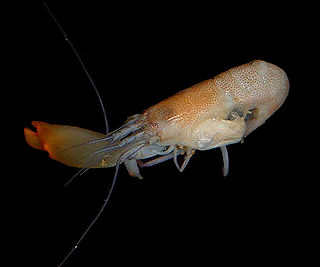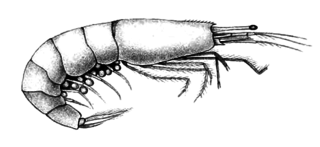
The Caridea, commonly known as caridean shrimp or true shrimp, from the Greek word καρίς, καρίδος, are an infraorder of shrimp within the order Decapoda. This infraorder contains all species of true shrimp. They are found widely around the world in both fresh and salt water. Many other animals with similar names – such as the mud shrimp of Axiidea and the boxer shrimp of Stenopodidea – are not true shrimp, but many have evolved features similar to true shrimp.

Dendrobranchiata is a suborder of decapods, commonly known as prawns. There are 540 extant species in seven families, and a fossil record extending back to the Devonian. They differ from related animals, such as Caridea and Stenopodidea, by the branching form of the gills and by the fact that they do not brood their eggs, but release them directly into the water. They may reach a length of over 330 millimetres (13 in) and a mass of 450 grams (1.0 lb), and are widely fished and farmed for human consumption.

The Decapoda or decapods are an order of crustaceans within the class Malacostraca, including many familiar groups, including crabs, lobsters, crayfish, shrimp, and prawns. Most decapods are scavengers. The order is estimated to contain nearly 15,000 species in around 2,700 genera, with around 3,300 fossil species. Nearly half of these species are crabs, with the shrimp and Anomura including hermit crabs, porcelain crabs, squat lobsters making up the bulk of the remainder. The earliest fossils of the group date to the Devonian.

Stenopus hispidus is a shrimp-like decapod crustacean belonging to the infraorder Stenopodidea. Common names include coral banded shrimp and banded cleaner shrimp.

Thalassinidea is a former infraorder of decapod crustaceans that live in burrows in muddy bottoms of the world's oceans. In Australian English, the littoral thalassinidean Trypaea australiensis is referred to as the yabby, frequently used as bait for estuarine fishing; elsewhere, however, they are poorly known, and as such have few vernacular names, "mud lobster" and "ghost shrimp" counting among them. The burrows made by thalassinideans are frequently preserved, and the fossil record of thalassinideans reaches back to the late Jurassic.

Penaeidae is a family of marine crustaceans in the suborder Dendrobranchiata, which are often referred to as penaeid shrimp or penaeid prawns. The Penaeidae contain many species of economic importance, such as the tiger prawn, whiteleg shrimp, Atlantic white shrimp, and Indian prawn. Many prawns are the subject of commercial fishery, and farming, both in marine settings, and in freshwater farms. Lateral line–like sense organs on the antennae have been reported in some species of Penaeidae. At 210 metres per second (760 km/h), the myelinated giant interneurons of pelagic penaeid shrimp have the world record for impulse conduction speed in any animal.

Synalpheus is a genus of snapping shrimp of the family Alpheidae, presently containing more than 160 species; new ones are described on a regular basis, and the exact number even of described species is disputed.

Discoplax is a genus of terrestrial crabs. It is very closely related to the genus Cardisoma.

Streptocephalus woottoni, with the common name Riverside fairy shrimp, is a rare species of crustacean in the family Streptocephalidae. It is native to Southern California in the United States, and northern Baja California in northwest Mexico.

Troglocaris is a genus of freshwater shrimp in the family Atyidae. These stygobitic, whitish and eyeless shrimp are found in Southern Europe. Although locally very common, the small ranges of the individual species make them highly vulnerable to habitat loss, for example by water extraction. Their underground habitat is often extremely stable; for example, the Vipavska jama cave in Slovenia is home to a population of T. anophthalmus, and its water only varies from 10 °C (50 °F) in the winter to 11 °C (52 °F) in the summer. In some Dinaric caves, notably Vjetrenica, as many as three species may occur together.

Squilla mantis is a species of mantis shrimp found in shallow coastal areas of the Mediterranean Sea and the Eastern Atlantic Ocean: it is also known as "pacchero" or "canocchia". Its abundance has led to it being the only commercially fished mantis shrimp in the Mediterranean.

Benthesicymus is a genus of prawns, containing the following species:

A shrimp is a crustacean with an elongated body and a primarily swimming mode of locomotion – typically belonging to the Caridea or Dendrobranchiata of the decapod order, although some crustaceans outside of this order are also referred to as "shrimp".
This list of fossil arthropods described in 2014 is a list of new taxa of trilobites, fossil insects, crustaceans, arachnids and other fossil arthropods of every kind that have been described during the year 2014. The list only includes taxa at the level of genus or species.

Ogrydes'' is a genus of decapod crustaceans consisting of 13 species. It is the only genus n the monotypic family Ogyrididae.

Synalpheus pinkfloydi, the Pink Floyd pistol shrimp, is a species of snapping shrimp in the genus Synalpheus. Described in 2017, it was named after the rock band Pink Floyd, in part because it has a distinctive "bright pink-red claw". The sound it makes by snapping the claw shut reaches 210 decibels, and can kill nearby small fish.
Gennadas elegans is a species of shrimps in the family Benthesicymidae. It is found on the east coast of the United States.

Benthesicymidae is a family of shrimps in the suborder Dendrobranchiata.

Callichirus major sensu lato is a monophyletic species complex of ghost shrimp in the infraorder Axiidea, found in flat sandy beaches across the Pan-American coastline.
2023 in arthropod paleontology is a list of new arthropod fossil taxa, including arachnids, crustaceans, trilobites, and other arthropods that were announced or described, as well as other significant arthropod paleontological discoveries and events which occurred in 2023.
















